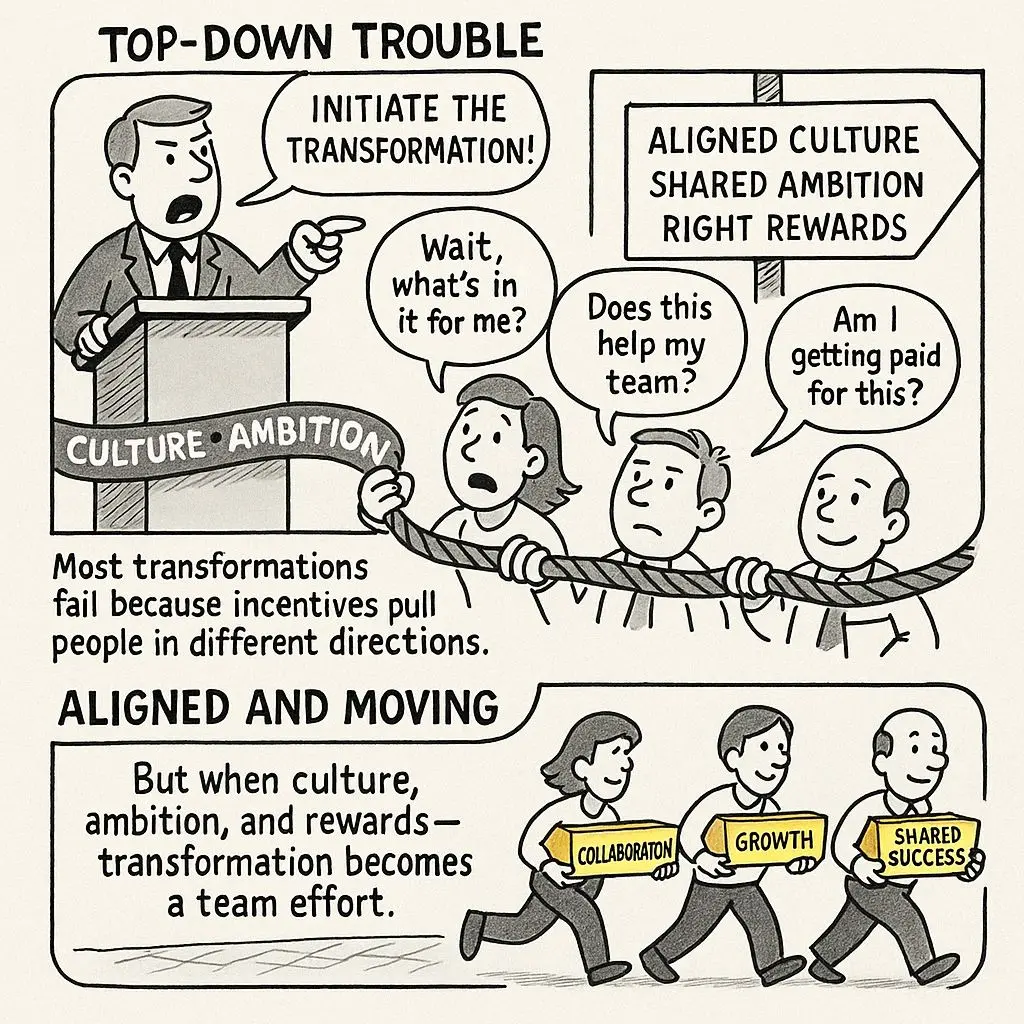Introduction: Why Most Transformations Fail
Organizational transformation is notoriously challenging, studies suggest that up to 70% of these initiatives fail to achieve their goals. Many reasons contribute to this high failure rate, including misaligned incentives, cultural resistance, and oversimplified, top‐down strategies. Relying solely on leadership mandates ignores the complex interplay of human motivation and behavior. For transformation to be successful, organizations must carefully align incentives across three dimensions: culture, ambition, and monetary rewards. When these elements reinforce one another, they build the momentum needed for change. Otherwise, misaligned incentives can lead to inertia and stagnation.

The Flawed Top-Down Approach: Why Directives Alone Aren’t Enough
Many transformation initiatives stumble because they assume that leadership directives alone are sufficient. While executive buy-in is critical, top-down strategies often overlook the individual and team-level incentives that drive behavior. When employees are expected to adopt new tools or processes without a supportive framework, misaligned cultural, career, and financial incentives can prompt them to prioritize personal or departmental goals over the organization’s broader objectives. The result is a fragmented effort that may quickly devolve into a “death march” an initiative that stalls because of resistance and waning enthusiasm.
The Three Dimensions of Aligned Incentives
1. Culture: Fostering Collaboration and Creativity
Culture wields the power to either enable or hinder transformation. Consider Pixar’s “Braintrust” meetings, where open, honest feedback and active collaboration are the norm, this environment has helped spark creative breakthroughs that resulted in blockbuster films. In stark contrast, a culture dominated by fear and punitive measures suppresses creativity and stifles initiative. Organizations must focus on nurturing a positive environment that values collaboration, embraces risk, and reinforces a shared sense of purpose.
2. Ambition: Aligning Career Growth with Organizational Goals
Ambition drives personal and career development, but its benefits are realized only when individual aspirations sync with organizational goals. Microsoft’s transformation under Satya Nadella is a case in point: by cultivating a growth mindset, the company aligned employee ambitions with broader business objectives, sparking innovation and market resurgence. However, when ambition is unchecked, it can lead to counterproductive behaviors such as hoarding knowledge or internal competition. Successful transformation, therefore, hinges on harmonizing individual career growth with team and organizational success.
3. Monetary Rewards: Encouraging the Right Behaviors
Financial incentives can provide short-term boosts in performance, but they must be designed carefully to avoid unintended consequences. If incentives reward quantity over quality or individual gain over collaborative effort, they can undermine long-term objectives. Salesforce, for example, restructured its reward system to emphasize knowledge sharing and exceptional customer service rather than just individual performance. This approach underscores the importance of carefully designed incentives that reinforce the values of collaboration and shared achievement.
Building Momentum with Carrots, Not Sticks
Effective transformation relies on positive reinforcement rather than punitive measures. Celebrating small wins, encouraging continuous learning, and fostering a supportive community can drive momentum and reinforce trust. In environments where achievements are recognized and failures are treated as learning opportunities, employees are more likely to innovate and collaborate. On the other hand, approaches that rely on penalties or public shaming can erode trust and dampen morale, ultimately stifling creativity and engagement.
Breaking the “Death March”
Transformation efforts often falter when organizations try to implement sweeping changes without first addressing underlying issues. Misaligned incentives, whether cultural, ambitious, or monetary, can create a cycle of resistance and disengagement. To break this cycle, organizations should:
- Start with Quick Wins: Identify and resolve small pain points to demonstrate tangible progress and build trust across the organization.
- Align Incentives: Ensure that the incentives at all levels, from cultural norms to financial rewards, support the initiative’s overall objectives, emphasizing teamwork over siloed achievements.
- Foster Collaboration: Create an environment that empowers employees to share ideas and voice concerns through robust communication channels and cross-functional teams.
- Build a Positive Culture: Encourage a culture of experimentation, learning, and celebration, steering clear of punitive measures that breed fear and resistance.
Frameworks and Tools for Lasting Change
While aligning incentives is crucial, leveraging practical frameworks and tools can further solidify transformation efforts:
Lighthouse Teams: Role Models for Success
Designate cross-functional teams to act as champions of change. These teams propagate best practices and share successes, creating a ripple effect throughout the organization. Spotify’s “Squads” model, where small, autonomous teams pursue specific goals and share their achievements, serves as a powerful example of this approach.
Inter-Team Mobility: Breaking Down Silos
Encourage movement and knowledge exchange between different teams. For instance, Amazon’s internal mobility programs foster cross-team interactions, enabling employees to share expertise and drive innovative solutions across departmental boundaries.
Watercooler Conversations: Building Informal Connections
Sometimes, informal interactions can be just as powerful as structured meetings. Tools that facilitate casual conversations can boost morale, spark new ideas, and build a resilient culture of momentum and optimism, much like Slack’s internal use of its own platform to nurture creative exchange.
Conclusion: Building Momentum for Meaningful Change
Transformation is not a one-size-fits-all proposition, it’s a multifaceted endeavor that goes beyond technology or strategy. Lasting change requires an environment where cultural, ambitious, and monetary incentives are aligned and where collaboration is encouraged and celebrated. By focusing on quick wins, positive reinforcement, and practical frameworks like Lighthouse Teams and inter-team mobility, organizations can break the cycle of resistance and foster a culture of innovation. Ultimately, true transformation is built on momentum and collective engagement, not force.